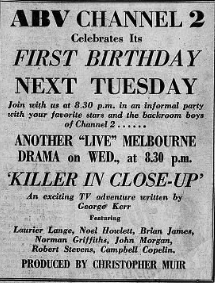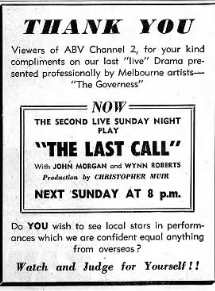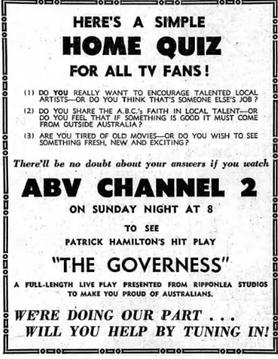The Lark is a 1952 play about Joan of Arc by the French playwright Jean Anouilh.. It was first presented at the Théâtre Montparnasse, Paris in October 1953. Translated into English by Christopher Fry in 1955, it was then adapted by Lillian Hellman for the Broadway production in the same year.
Black Chiffon is a play in two acts written by Lesley Storm. Starring Flora Robson, the play premiered at the Westminster Theatre in London's West End on 3 May 1949, running for over 400 performances. The play debuted on Broadway on 27 September 1950 and ran until 13 January 1951, totalling 109 performances. That production starred Janet Barrow (Nannie), Richard Gale, Patricia Hicks (Louise), Raymond Huntley, Anthony Ireland, Patricia Marmont (Thea), and Flora Robson, and was produced by John Wildberg.

Shell Presents was an early attempt at Australian television drama, being an umbrella title for several different productions. It debuted on 4 April 1959, and aired on ATN-7 and GTV-9, who split production of plays for the series between them. It was an anthology series, each program being a self-contained play for television. The series won a Logie award in 1960 for TV Highlight of 1959. As the title suggests, it was sponsored by Shell. It was described as "a very big deal for the station: major institutional sponsorship from international companies for locally produced drama." It would be followed by The General Motors Hour.
Ending It was a 1939 BBC TV one-off play, written by Val Gielgud, and starring John Robinson, Joan Marion, and Dino Galvani. It was 30 minutes in duration. It was broadcast live on 25 August 1939.
Roundabout is a television movie, or rather a live television play, which aired on Australian television in 1957. Broadcast 4 January 1957 on ABC station ABV-2, it is notable as the first example of television drama produced in Melbourne.

"They Were Big, They Were Blue, They Were Beautiful" is an Australian television movie, or rather a live television play, which aired live on 27 June 1959 in Sydney, and on 8 August 1959 in Melbourne. It aired as part of Shell Presents, a monthly presentation of standalone productions which aired from 1959 to 1960 on ATN-7 in Sydney and GTV-9 in Melbourne.
Treason is a 1959 Australian television live drama, which aired on ABC about the 20 July plot during World War Two. Originally broadcast 16 December 1959 in Melbourne, a kinescope ("telerecording") was made of the program and shown in Sydney on 13 January 1960. It was an adaptation of a stage play by Welsh writer Saunders Lewis, which had previously been adapted as an episode of BBC Sunday-Night Theatre.

Killer in Close-Up was a blanket title covering four live television drama plays produced by the Australian Broadcasting Commission in 1957 and 1958. It could be seen as the first anthology series produced for Australian television.
Citizen of Westminster is an early example of Australian television drama which aired on ABC. A one-off play set in England, it aired live on 8 October 1958 in Sydney, and kinescoped for showing in Melbourne on 30 November 1958. Australian TV drama was relatively rare at the time.

The Sound of Thunder is a 1957 Australian television play by Australian writer Iain MacCormick. It starred Moira Carleton. It was described as "the longest and most ambitious play ABN [the ABC] has put over so far" although The Importance of Being Ernest, which followed on December 18, exceeded it by 12 minutes.
An Enemy of the People is a 1958 Australian television play starring James Condon. It was based on the 1882 play by Henrik Ibsen and was updated to a contemporary Australian setting. It was broadcast live.
Small Victory is a 1958 television play broadcast by the Australian Broadcasting Corporation. It was set during the Korean War. It was directed by William Sterling and was shot in Melbourne where it aired 26 March 1958.
Gaslight is a 1958 television play broadcast by the Australian Broadcasting Corporation based on the 1938 play Gas Light by Patrick Hamilton. It starred Beverley Dunn.

Last Call is a 1958 Australian TV play set in a South American country. It was directed by Christopher Muir.

The Governess is a 1958 television play broadcast by the Australian Broadcasting Corporation based on a play by Patrick Hamilton, which had been performed several times on Australian radio. It was directed by William Sterling who had previously directed an adaptation of Hamilton's Gaslight (1958).
Marriage Lines is a 1962 Australian television play directed by Christopher Muir.
A Rose without a Thorn is a 1958 Australian television play about King Henry VIII's marriage to Catherine Howard. It was directed by Alan Burke from a play by Clifford Bax. The play was shown live in Sydney, recorded, then shown in Melbourne.

Light Me a Lucifer is a 1962 Australian television comedy film which aired on ABC. Written by John O'Grady, it starred Frank Thring as the devil, along with Wyn Roberts, Edward Howell, Joan Harris, Ken Goodlet and Lynne Flanagan. It was produced in Melbourne.
"Suspect" is a 1961 Australian television play. It was originally made for HSV-7 then presented as part of the General Motors Hour It was produced by Peter Cotes, who had made Long Distance. "Suspect" aired on 3 June 1962 in Sydney and Melbourne, and on 7 October 1962 in Brisbane and Adelaide.

The Devil Makes Sunday is a 1962 Australian television play by New Zealand-born author Bruce Stewart. It was broadcast live from Melbourne, and taped and shown in other cities at a later date.








